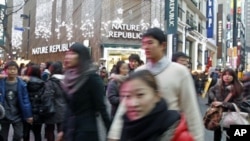The South Korean government is trying to make giving directions a little easier.
Small blue placards featuring new addresses have been hung up on every building around the country.
They are replacing an older address system some say was not very helpful without a map. But public reaction so far has been mixed to the new building numbers. Some in Korea say the change means a loss of cultural heritage.
Taxi driver Hong Jae-do punches an address into his dashboard-mounted GPS navigator. He has been a cabbie for about four years and says his job would be really hard without this device.
Hong says he relies on his GPS whenever he cannot find an address. Without it, he said he would have a really tough time, especially when he has to travel outside of Seoul.
Japanese model
One reason blamed for the difficulty in navigating is Korea’s address system. It is modeled on the Japanese system, which assigns addresses chronologically instead of geographically. In other words, buildings are numbered according to when they were built - not according to where they are located on a street.
But this complex system soon will be a thing of the past.
A TV commercial introduces viewers to Korea’s new address system, which the government here says will make it easier and quicker to order out food, send packages and get help in case of an emergency.
The new system is more Western-style, using only a building’s number, street and city.
Dual usage of the old and new system will be permitted until December 2013. That is when the Japanese-style addresses will be officially abandoned.
Buddhist opposition
But not everyone is excited about the new system. And, some of the strongest opposition comes from Buddhists.
Monks at Seoul’s Jogye Temple petitioned the government to hold off on using the new system.
Monk To-gyoung explained why his order opposes some of the addresses. He said there are areas and roads that are closely related to Buddhism. He said the monks are protesting because the names of these places are disappearing with the new address system, and they feel they are losing their heritage.
He said the monks do not oppose the new address system in general. They are only asking the government to not change the names of the roads that have a Buddhist connection.
Hopeful business owners
Officials of the South Korean Ministry of Public Administration and Security, the government body in charge of the new addresses, declined to be interviewed. But a spokeswoman said that the ministry is still working out the problems of implementing the new system.
Some business owners say the new building numbers could bring in more customers.
Yeon-il is the 70-year-old owner of a tea house located on a small alley in one of Seoul’s busy tourist neighborhoods. She is glad to see the old system go, she says, but is not getting her hopes up yet about the new street addresses.
She also says because of the way the old address system works, people do have a tough time finding her shop; sometimes, they walk right by it. But she says she is not so sure if the new system will make things any easier because there are so many small alleys in this neighborhood and all around the country. People need to be given clear directions, she says, and look for landmarks to know where to go.
Yeon-il points out that if people could not find what they were looking for under the old system, they still probably will not be able to find it now, no matter what numbers appear by the front door.





